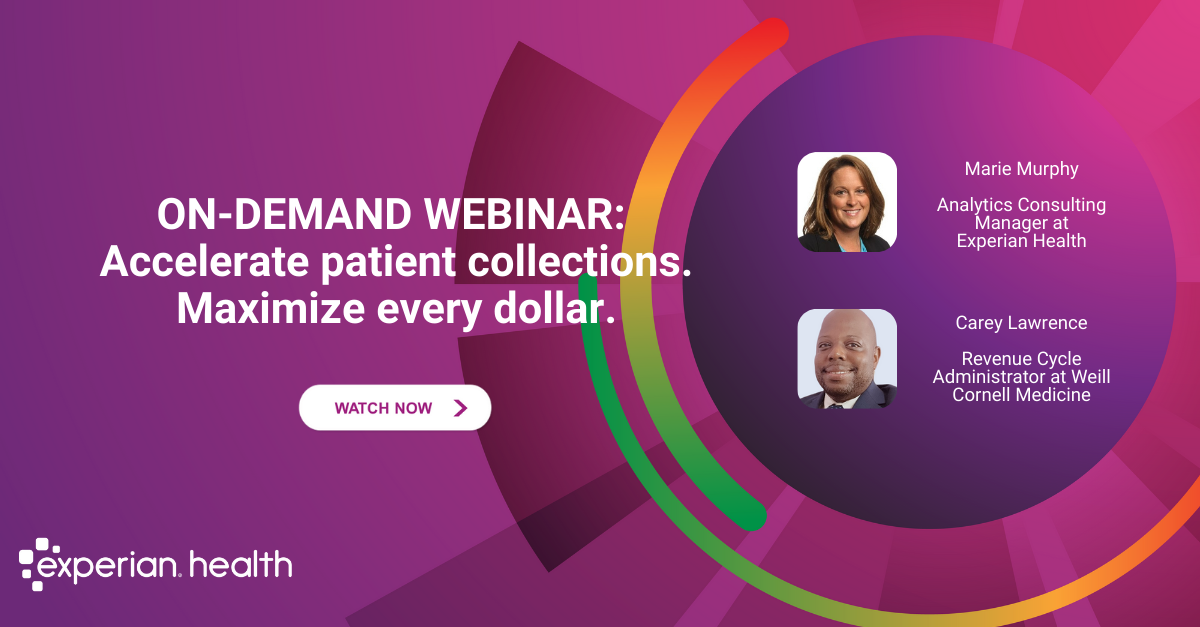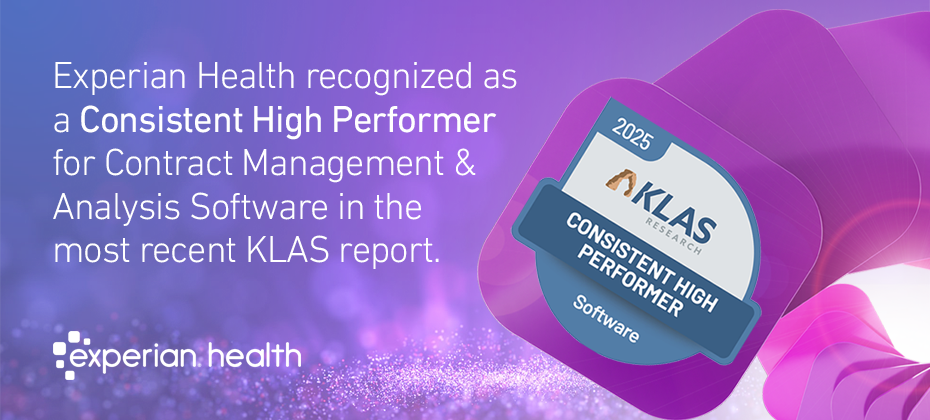At A Glance
In this guide to healthcare revenue cycle management, learn how healthcare organizations can optimize the revenue cycle process at every stage of the patient journey to increase reimbursements and improve operational efficiency.
Table of Contents
Key takeaways:
- Efficient revenue cycle management is crucial to ensuring efficient hospital operations and building financial stability.
- RCM technology solutions allow healthcare organizations to increase cash flow and improve operational efficiency across the entire revenue cycle.
- Revenue cycle management tools from Experian Health utilize data-driven insights, automation and AI to optimize revenue cycles, while supporting compliance and regulatory needs.
The revenue cycle management market is projected to grow to $238B by 2030. Revenue cycle management is a critical process that ensures healthcare organizations maintain healthy cash flow and keep operations running smoothly. However, keeping the financial scales tipped in the right direction can be a never-ending challenge for revenue cycle leaders. As hospital profit margins remain tight, technology-based RCM solutions can help revenue cycle leaders stay ahead and maximize reimbursements.
In this guide to revenue cycle management, providers will learn how to optimize revenue cycle processes at every stage of the patient journey.
What is revenue cycle management (RCM) in healthcare?
Revenue management in healthcare connects the financial and clinical aspects of patient care. The primary purpose of RCM is to help healthcare organizations ensure proper reimbursement and accurate, efficient billing and claims management processes. Seamless revenue cycle management also allows providers to maintain a solid financial foundation, a critical factor in boosting resilience during uncertain economic times.
Over the last few decades, RCM in healthcare has undergone numerous evolutions. Largely paper-based, manual processes have been replaced by sophisticated software-based systems and data-driven technology. As more organizations embrace the ongoing digital transformation of RCM in healthcare, processes now commonly include solutions that utilize machine learning, automation and artificial intelligence (AI).
Leveraging technology boosts efficiencies, streamlines operations and allows organizations to see quicker reimbursement rates. However, despite these upsides, switching to new modern revenue cycle management systems isn’t always a priority for providers. Many healthcare organizations still partially rely on outdated and disjointed systems that can result in reimbursement delays and other snags in the revenue cycle.
How the healthcare revenue cycle works
A typical healthcare revenue cycle follows the step-by-step lifecycle of a patient encounter, known as the patient journey. Every touchpoint is an opportunity for revenue cycle teams to ensure that patients, payers and back-office teams have the information needed to expedite payment.
Along with revenue cycle leaders, a wide range of healthcare staff are commonly involved in various administrative functions across the RCM cycle. Depending on the organization and how revenue cycle processes are set up, this may include front desk staff, scheduling teams, medical coders, billing staff and collections teams.
While individual healthcare organizations often customize their exact RCM process, most revenue cycles are generally broken down into several key phases of the patient journey: pre-visit, visit and post-visit. Each phase of the healthcare revenue cycle also has its own specific components, such as registration, claim submission and collections.
Key stages of the revenue cycle process commonly include:
- Pre-visit: This phase includes all of the steps of the patient journey that happen before treatment, such as preregistration, patient registration, insurance verification and prior authorization.
- Patient visit: The next phase includes revenue cycle activities related to the patient visit for treatment or services, such as documentation, coding and charge capture.
- Patient post-visit: This phase includes the steps of the patient journey after care has been received, such as claims submission, collections, payment posting, and any necessary follow-up.
Detailed breakdown of each revenue cycle stage
Successful healthcare revenue cycles consist of a series of stages. Each component of the RCM cycle is carefully designed to prevent revenue leaks and create a frictionless patient journey.
Here’s a detailed breakdown of what happens during each revenue cycle stage across the pre-visit, visit and post-visit phases of the patient journey:
- Patient registration: Gathers key patient information before service, including demographics, insurance, medical history and other personal details.
- Eligibility and benefits: Verifies patient insurance coverage status, checks for additional or unknown coverage and provides transparent, accurate estimates prior to service.
- Data entry: Maintains accuracy of patient information data, verifying and protecting patient identities to ensure the right information is linked with the right patient.
- Prior authorizations: Determines if prior authorizations are needed before service, submitting payer requests as needed.
- Patient encounter: Adds information about the services a patient receives to the patient record, setting the stage for accurate coding and billing.
- Charge posting: Submits claims to relevant payers using the appropriate charge posting or charge entry process — including a detailed breakdown of all services provided to the patient, patient information, history and insurance or payment plan status.
- Coding and billing: Checks payer codes for the services that have been delivered — using diagnostic (Dx) codes, place of service (POS) codes, current procedural terminology (CPT) codes, Healthcare Common Procedure Coding System (HCPCS) codes and others to determine payable amounts.
- Claims management: Submits claims and facilitates communication between providers and payers during the claims adjudication process, providing early intervention for denied claims and reworks as needed.
- Payer contract management: Ensures timely reimbursements — auditing payer performance, keeping track of changing requirements and identifying reimbursement discrepancies and patterns of non-reimbursement.
- Patient billing and collections: Bills patient for remaining amount owed after insurance reimbursement — collecting balances using in-house collections teams or outside collections agencies.
Common challenges in revenue cycle management (RCM)
To avoid escalating administrative costs and revenue leaks, teams must remain vigilant against challenges that disrupt the revenue cycle — including data errors, billing code mistakes, claims denials and payment delays. It can often be overwhelming for busy RCM leaders to sidestep obstacles. However, staying on top of challenges in revenue cycle management is critical to ensuring healthy cash flow and smooth-running daily operations.
Here’s a closer look at six common roadblocks RCM leaders need to keep tabs on:
- Incomplete documentation: Missing or outdated insurance information — and other missing or incorrect patient data — can lead to coding errors, claim denials and billing delays. Mistakes are most common when organizations use outdated manual processes, like paper forms.
- Coding errors: Mistakes made during billing code submissions — often due to error-prone manual processes or rapidly changing payer requirements — can lead to denials, delays and reworks.
- Claim denials: Claims denials are on the rise, leaving healthcare organizations to face potential hits to the bottom line from delayed or unpaid claims, while adding extra administrative burden for reworks.
- High days in accounts receivable: Collection delays are often a major roadblock in the revenue cycle — disrupting cash flow and potentially leading to extra administrative costs and bad debt.
- Patient payment responsibility increases: Rising healthcare costs, including out-of-pocket expenses and high-deductible healthcare plans, put more financial burdens on today’s patients, leaving many struggling to pay their medical bills.
- Regulatory complexity: New price transparency regulations, implementation of the One Big Beautiful Bill Act, patient privacy safeguards under the Health Insurance Portability and Accountability Act (HIPAA), payer compliance changes and other rapidly evolving healthcare requirements can bottleneck revenue cycle processes and slow down reimbursements.
Strategies to improve healthcare revenue cycle performance
Leaders tasked with improving healthcare revenue cycle performance can adopt RCM strategies that turn roadblocks into opportunities for growth. Here are five strategies to streamline RCM processes, boost performance and maximize revenue.
Implement automation
Quick, accurate and efficient patient access processes are the foundation of healthy revenue cycles. Revenue cycle leaders should look at technology-forward solutions that leverage automation to boost efficiencies across all stages of the revenue cycle – from registration and scheduling to prior authorizations, claims processing and collections.
Utilize real-time eligibility checks
Finding missing health insurance is critical to keeping revenue cycles on track. Real-time insurance eligibility verification allows providers to quickly confirm active coverage at any point in the revenue cycle, including additional coverage a patient may have forgotten.
Avoid solutions that require heavy staff training or certifications
Revenue cycle management solutions that are easy to onboard and require little to no staff training or special certifications are often more efficient to implement and utilize — minimizing administrative costs and allowing busy staff to focus on other priorities.
Consider outsourcing vs. in-house billing
Implementing tools that streamline key steps in the RCM process—like coding, claims submissions and collections—allows busy billing teams to maximize their time, save on administrative costs, accelerate collections, and avoid unnecessary outsourcing to third parties.
Choose the right metrics to monitor
Identifying and monitoring key revenue cycle performance indicators (KPIs) aligned to specific RCM priorities offers real-time insights into key stages across the revenue cycle — including patient access, collections, claims and contract management.
Check out this guide to choosing the right key performance indicators for your revenue cycle dashboard to ensure the effective implementation of RCM strategies.
RCM in the era of modern technology and AI
Reimbursement delays commonly stem from error-prone manual revenue cycle processes. Overworked staff burdened by time-consuming administrative tasks related to RCM often further compound reimbursement issues. However, adopting solutions that utilize revenue cycle management automation, machine learning and AI allows healthcare organizations to overcome numerous pain points and ensure prompt reimbursement.
While constantly evolving, today’s top revenue cycle management technology often relies on:
- Interoperability and data integration: Data-driven, turnkey revenue cycle management healthcare tools share data and function together seamlessly across the revenue cycle — using machine learning, automation and AI to constantly improve RCM.
- Patient engagement tools and payment portals: AI-powered patient engagement tools and automated solutions improve patient access and accelerate collections rates.
- Use of predictive analytics: Built-in predictive analytics offer actionable insights that improve patient access, claims processing, collections and other key areas of the revenue cycle.
Revenue cycle management case studies
Exact Sciences
Ken Kubisty, VP of Revenue Cycle at Exact Sciences, shares how Experian Health’s Patient Access Curator™ helped their organization reduce claim denial errors and added $75 million in insurance company collections.
Community Medical Centers
Brandon Burnett, VP, Revenue Cycle at Community Medical Centers, shares how their organization partnered with Experian Health to implement AI Advantage™, which uses artificial intelligence to prevent and triage claims denials.
Weill Cornell Medicine
In a recent on-demand Webinar, we shared how Weill Cornell Medicine and Experian Health implemented a smarter collections strategy that delivered $15 million in recoveries using Collections Optimization Manager.

How to choose the right RCM software or vendor
Revenue cycle leaders who want to improve their organization’s RCM process often benefit from implementing RCM software or partnering with a vendor that specializes in healthcare revenue cycle digital solutions.
When choosing a solution, look for these key features:
- Patient access tools to improve registration, scheduling, estimates and payments.
- Insurance verification software with the ability to perform real-time eligibility checks and stay on top of ever-evolving regulations and payer policies.
- Claims management solutions that improve accuracy and efficiencies across claims submission and denials management processes.
- Collections software to streamline patient collections and reduce bad debt.
- Contract management tools to audit payer compliance against contract terms and maximize reimbursement rates.
- Data and analytics tools to monitor the revenue cycle, track key performance metrics and gain valuable insights.
Questions to ask vendors
Vetting vendors is critical to finding the best RCM software. Each healthcare organization has unique needs, so it’s important to vet vendors carefully to find the right revenue cycle management solutions.
Consider these questions when scoping out revenue cycle software solutions and vendors:
- Implementation: What’s the implementation process like? How does staff training and onboarding work?
- Integration: Will the RCM software work with legacy systems? If not, what processes can it replace?
- Customization: What types of customization options are available? What legacy systems are supported?
- Scalability: How flexible is the solution? Does the RCM software have the ability to scale?
- Usability: Is the software user-friendly? How easy is it to navigate the platform, share data and manage multiple stages of the revenue cycle?
- Reporting: What types of reporting and analytics are built-in? Can KPIs be customized?
- Cost: How does pricing work? Is it determined by functionality? Number of users? Size of organization?
- Customer support: What type of customer support is available? Will the organization have a dedicated customer service representative? Are experts available to help customize the software for the organization’s needs or analyze data?
Build vs. buy decision-making
Adopting technology to streamline revenue cycle management is often a large investment. Finding the best solution often comes down to the healthcare organization’s unique needs, including budget, existing technology stack and other factors.
Ultimately, the tools chosen will have a significant impact on an organization’s financial and operational health, making the decision to build a custom solution or purchase turnkey RCM software a critical one. While there’s no “right” choice, revenue cycle leaders should consider the pros and cons and vet vendors carefully to help ensure long-term success.
Why choose Experian Health for revenue cycle management
Working with an industry-leading revenue cycle software solution partner, like Experian Health, allows healthcare organizations to modernize and speed up their entire revenue cycle management process. Experian Health offers a wide range of award-winning revenue cycle management tools that allow organizations to optimize every stage of the revenue cycle — from patient access to collections, claims management and payer contract management.
Robust automated solutions help organizations eliminate manual processes, submit cleaner claims, maximize collections and cash flow – all while staying compliant with the latest regulations and improving the patient experience at every stage of the journey. Experian Health’s built-in RCM analytics leverage data to analyze, track and further optimize performance.
Turning revenue cycle roadblocks into opportunities for growth
Today’s healthcare revenue cycle leaders face more RCM obstacles than ever before — from increasingly complex billing processes and rising healthcare costs to frequent regulatory and payer requirements and staff shortages. However, providers also have unprecedented access to RCM technology solutions designed to streamline all stages of the revenue cycle management process. Healthcare organizations that embrace RCM software solutions – especially tools that use AI, automation and machine learning – can optimize revenue cycle management, boost overall financial resiliency and keep revenue flowing for many years to come.
Learn more about how Experian Health’s revenue cycle management solutions can help healthcare organizations generate more revenue and increase their bottom lines.


